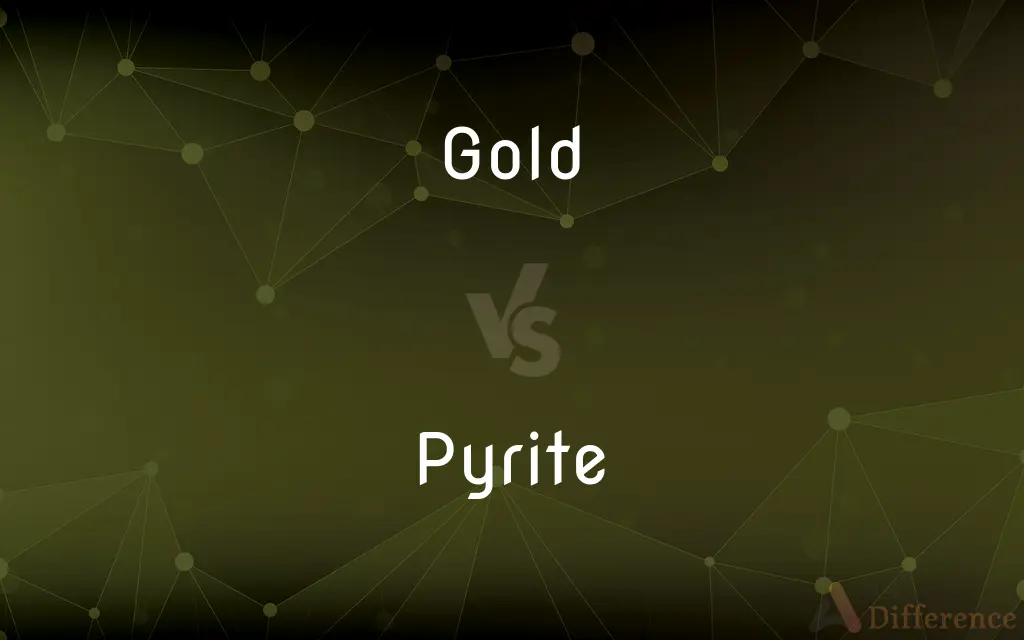Gold vs. Pyrite — What's the Difference?
By Urooj Arif & Fiza Rafique — Updated on April 17, 2024
Gold is a naturally occurring precious metal with a soft, shiny yellow appearance; pyrite, often called fool's gold, is harder, with a metallic luster and brass-yellow hue.

Difference Between Gold and Pyrite
Table of Contents
ADVERTISEMENT
Key Differences
Gold is highly valued for its rarity, malleability, and distinctive soft yellow color, making it ideal for jewelry and investment. On the other hand, pyrite, which is composed of iron sulfide, features a brass-yellow color that can superficially resemble gold but is significantly harder and more brittle.
While gold is a dense, ductile metal that can be easily shaped and stretched, pyrite is brittle and will shatter when struck rather than bending or deforming.
Gold is chemically inert, meaning it does not oxidize easily and maintains its luster over time, which is why it is often found in elemental form in nature. In contrast, pyrite can oxidize and degrade into iron oxides and sulfate when exposed to moisture and air.
In terms of applications, gold's uses extend beyond jewelry into electronics and as a financial commodity. Whereas pyrite, despite its misleading appearance, is primarily used in the production of sulfuric acid and as a source of sulfur in industrial processes.
Comparison Chart
Composition
Elemental metal (Au)
Iron sulfide (FeS2)
ADVERTISEMENT
Color
Shiny, soft yellow
Brass-yellow, metallic luster
Hardness
Soft (2.5–3 on Mohs scale)
Relatively hard (6–6.5 on Mohs scale)
Malleability
Highly malleable and ductile
Brittle, breaks easily
Reaction to Air
Chemically inert, does not tarnish
Oxidizes and can degrade
Primary Uses
Jewelry, electronics, investment
Sulfuric acid production, mineral specimens
Compare with Definitions
Gold
A dense, soft, shiny yellow metallic element, highly valued for jewelry and investment.
The price of gold has historically been a reflection of economic stability.
Pyrite
Often found in crystal form, displaying cubic or octahedral shapes.
The geometric crystals of pyrite make it a favorite among mineral collectors.
Gold
Chemically inert, meaning it resists corrosion and tarnishing.
Gold artifacts from ancient civilizations remain lustrous even after thousands of years.
Pyrite
Used industrially to produce sulfur dioxide for sulfuric acid.
Pyrite is thermally decomposed to extract sulfur dioxide for industrial uses.
Gold
Traded globally as a commodity; often bought during times of economic uncertainty.
Investors often buy gold as a safe haven during financial turmoil.
Pyrite
An iron sulfide mineral, known for its metallic luster and pale brass-yellow hue.
Pyrite is commonly mistaken for gold by novice prospectors.
Gold
Commonly used in electronics due to its excellent conductivity.
Gold is used in high-end electronic connectors for reliable performance.
Pyrite
Brittle and can easily shatter, contrasting with the malleability of gold.
Unlike gold, pyrite will crack and break when struck with a hammer.
Gold
Malleable and ductile, making it ideal for crafting fine jewelry.
Artisans prefer gold for intricate jewelry designs due to its malleability.
Pyrite
Prone to oxidation, forming rust-like iron oxides over time.
Pyrite exposed to weathering processes can develop a rusty exterior.
Gold
Gold is a chemical element with the symbol Au (from Latin: aurum) and atomic number 79, making it one of the higher atomic number elements that occur naturally. In a pure form, it is a bright, slightly reddish yellow, dense, soft, malleable, and ductile metal.
Pyrite
The mineral pyrite (), or iron pyrite, also known as fool's gold, is an iron sulfide with the chemical formula FeS2 (iron (II) disulfide). Pyrite is the most abundant sulfide mineral.
Gold
A yellow precious metal, the chemical element of atomic number 79, used especially in jewellery and decoration and to guarantee the value of currencies.
Gold earrings
Pyrite
A brass-colored mineral, FeS2, occurring widely and used as an iron ore and in producing sulfur dioxide for sulfuric acid. Also called fool's gold, iron pyrites.
Gold
A deep lustrous yellow or yellow-brown colour
Her eyes were light green and flecked with gold
Pyrite
(mineral) The common mineral iron disulfide (FeS2), of a pale brass-yellow color and brilliant metallic luster, crystallizing in the isometric system.
Gold
Coins or other articles made of gold
Her ankles and wrists were glinting with gold
Pyrite
(usually as a plural: pyrites) Any metallic-looking sulphide, such as the above, which is the most common.
Gold
The bullseye of an archery target.
Pyrite
(usually as a plural: pyrites) Any metal dichalcogenide that is isostructural to the common mineral.
Copper diselenide can occur both as a marcasite and a pyrite.
Gold
Symbol Au A soft, yellow, corrosion-resistant element, the most malleable and ductile metal, occurring in veins and alluvial deposits and recovered by mining, panning, or sluicing. A good thermal and electrical conductor, gold is generally alloyed to increase its strength, and it is used as a common monetary standard, in jewelry, for decoration, and as a plated coating on a wide variety of electrical and mechanical components. Atomic number 79; atomic weight 196.967; melting point 1,064.2°C; boiling point 2,856.0°C; specific gravity 19.3; valence 1, 3. See Periodic Table.
Pyrite
A common mineral of a pale brass-yellow color and brilliant metallic luster, crystallizing in the isometric system; iron pyrites; iron disulphide.
Hence sable coal his massy couch extends,And stars of gold the sparkling pyrite blends.
Gold
Coinage made of this element.
Pyrite
A common mineral (iron disulfide) that has a pale yellow color
Gold
A gold standard.
Gold
Money; riches.
Gold
A light olive-brown to dark yellow, or a moderate, strong to vivid yellow.
Gold
Something regarded as having great value or goodness
A heart of gold.
Gold
A medal made of gold awarded to one placing first in a competition, as in the Olympics
Won 9 golds in 13 events.
Gold
Having the color of gold.
Gold
(uncountable) A heavy yellow elemental metal of great value, with atomic number 79 and symbol Au.
Gold
A coin or coinage made of this material, or supposedly so.
The pirates were searching for gold.
Gold
(uncountable) A deep yellow colour, resembling the metal gold.
Gold
(countable) The bullseye of an archery target.
Daniel hit the gold to win the contest.
Gold
(countable) A gold medal.
France has won three golds and five silvers.
Gold
(figuratively) Anything or anyone that is very valuable.
That food mixer you gave me is absolute gold, mate!
Gold
A grill jewellery worn on front teeth made of gold.
Gold
Made of gold.
A gold chain
Gold
Having gold of gold.
Gold sticker
Gold socks
Gold
(of commercial services) Premium, superior.
Gold
Of a musical recording: having sold 500,000 copies.
Gold
In a finished state, ready for manufacturing.
Gold
To appear or cause to appear golden.
Gold
Of or referring to a gold version of something
Gold
An old English name of some yellow flower, - the marigold (Calendula), according to Dr. Prior, but in Chaucer perhaps the turnsole.
Gold
A metallic element of atomic number 79, constituting the most precious metal used as a common commercial medium of exchange. It has a characteristic yellow color, is one of the heaviest substances known (specific gravity 19.32), is soft, and very malleable and ductile. It is quite unalterable by heat (melting point 1064.4° C), moisture, and most corrosive agents, and therefore well suited for its use in coin and jewelry. Symbol Au (Aurum). Atomic weight 196.97.
Gold
Money; riches; wealth.
For me, the gold of France did not seduce.
Gold
A yellow color, like that of the metal; as, a flower tipped with gold.
Gold
Figuratively, something precious or pure; as, hearts of gold.
Gold
Coins made of gold
Gold
A deep yellow color;
An amber light illuminated the room
He admired the gold of her hair
Gold
A soft yellow malleable ductile (trivalent and univalent) metallic element; occurs mainly as nuggets in rocks and alluvial deposits; does not react with most chemicals but is attacked by chlorine and aqua regia
Gold
Great wealth;
Whilst that for which all virtue now is sold, and almost every vice--almighty gold
Gold
Something likened to the metal in brightness or preciousness or superiority etc.;
The child was as good as gold
She has a heart of gold
Gold
Made from or covered with gold;
Gold coins
The gold dome of the Capitol
The golden calf
Gilded icons
Gold
Having the deep slightly brownish color of gold;
Long aureate (or golden) hair
A gold carpet
Common Curiosities
Can gold and pyrite be distinguished by hardness?
Yes, gold is much softer (2.5-3 on the Mohs scale) compared to pyrite (6-6.5).
Can pyrite be used in jewelry?
Pyrite is sometimes used in jewelry but is less desirable due to its brittleness and tendency to oxidize.
What is the main visual difference between gold and pyrite?
Gold has a softer, more yellow appearance, while pyrite is more metallic and brass-like.
Why does gold not tarnish like other metals?
Gold is chemically inert and does not react easily with other elements, preventing tarnish.
Is pyrite valuable like gold?
No, despite its appearance, pyrite is not nearly as valuable as gold.
How is gold extracted from the earth?
Gold is mined either from lode deposits by drilling and blasting or from placer deposits by panning and sluicing.
Is gold a good conductor of electricity?
Yes, gold is an excellent conductor of electricity, which is why it is valuable in electronics.
Why might investors choose gold over pyrite?
Investors value gold for its monetary stability and intrinsic value, unlike pyrite.
What are the industrial uses of pyrite?
Pyrite is primarily used in the manufacture of sulfuric acid and as a source of sulfur.
What tests can differentiate gold from pyrite?
Simple tests like hardness, streak, and specific gravity tests can help distinguish them.
Are there any health risks associated with pyrite?
Pyrite dust can be harmful if inhaled, and its oxidation can lead to environmental hazards.
Does pyrite have any role in historical scams?
Pyrite has been involved in various mining scams due to its deceptive gold-like appearance.
How is the market price of gold determined?
The price of gold is influenced by supply, demand, and global economic conditions.
What happens to pyrite when exposed to water and air?
Pyrite oxidizes, forming iron oxides and sulfate, which can lead to acid mine drainage.
What cultural significance does gold hold?
Gold has been a symbol of wealth, power, and status across various cultures and ages.
Share Your Discovery

Previous Comparison
Hereafter vs. Henceforth
Next Comparison
Cheeseburger vs. HamburgerAuthor Spotlight
Written by
Urooj ArifUrooj is a skilled content writer at Ask Difference, known for her exceptional ability to simplify complex topics into engaging and informative content. With a passion for research and a flair for clear, concise writing, she consistently delivers articles that resonate with our diverse audience.
Co-written by
Fiza RafiqueFiza Rafique is a skilled content writer at AskDifference.com, where she meticulously refines and enhances written pieces. Drawing from her vast editorial expertise, Fiza ensures clarity, accuracy, and precision in every article. Passionate about language, she continually seeks to elevate the quality of content for readers worldwide.














































